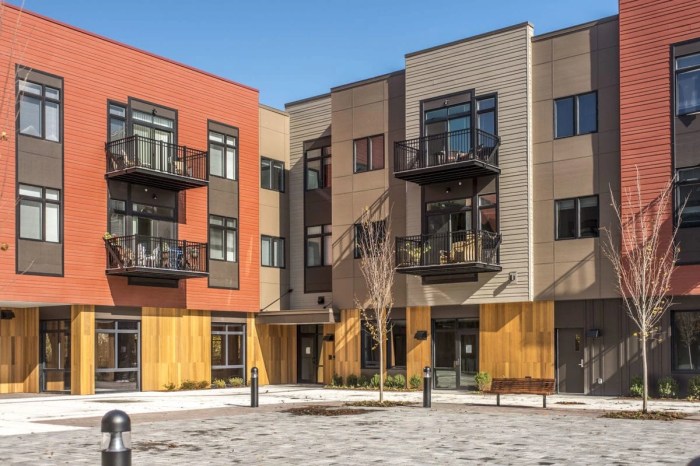Multifamily Investment Properties A Comprehensive Guide

Multifamily investment properties offer a compelling avenue for investors seeking to diversify their portfolios and generate passive income. From apartments and townhouses to duplexes and even larger multifamily complexes, these properties provide a unique blend of stability and potential for appreciation. This comprehensive guide delves into the intricacies of multifamily investment, covering everything from market analysis and due diligence to financing options and property management strategies. Whether you are a seasoned investor or just starting your journey, this guide will equip you with the knowledge and tools to make informed decisions and navigate the dynamic world of multifamily real estate.
Understanding the fundamentals of multifamily investment is crucial for success. This includes identifying the different types of multifamily properties, analyzing market trends, and conducting thorough due diligence. Moreover, investors need to consider financing options, develop effective property management strategies, and stay abreast of relevant tax implications and legal considerations. This guide will explore these essential aspects in detail, providing insights and practical advice to guide your investment journey.
Multifamily Investment Properties
Multifamily investment properties are real estate investments that involve owning and operating properties with multiple dwelling units, such as apartments, townhouses, and duplexes. These properties are designed to generate income through rental payments from multiple tenants.
Types of Multifamily Properties
Multifamily properties can be categorized into different types based on the number of units and the structure of the building. Here are some common types:
- Apartments: Apartments are the most common type of multifamily property, offering a range of unit sizes and configurations. They are typically found in urban and suburban areas and can be part of high-rise buildings or smaller complexes.
- Townhouses: Townhouses are individually owned units that share common walls with neighboring units. They often have a small yard or patio and offer more privacy than apartments.
- Duplexes: Duplexes are buildings with two separate dwelling units, each with its own entrance and amenities. They are a popular option for investors seeking a smaller-scale multifamily investment.
- Triplexes and Quadplexes: These properties have three or four separate units, respectively, and offer a slightly larger investment opportunity than duplexes.
- Mixed-Use Properties: These properties combine residential units with commercial spaces, such as retail stores or offices. They offer the potential for diversification of income streams.
Benefits of Investing in Multifamily Properties, Multifamily investment properties
Investing in multifamily properties can offer several potential benefits for investors:
- Passive Income: Rental income from tenants provides a consistent stream of passive income.
- Appreciation: Real estate values generally appreciate over time, potentially increasing the value of your investment.
- Tax Advantages: Multifamily investments offer various tax deductions, including depreciation, interest expense, and property taxes.
- Diversification: Investing in multifamily properties diversifies your investment portfolio, reducing overall risk.
- Inflation Hedge: Rental income can increase with inflation, helping to protect your investment against rising costs.
- Long-Term Stability: Multifamily properties offer a long-term investment opportunity, providing consistent returns over time.
Financing and Investment Strategies
Securing financing and choosing the right investment strategy are crucial for success in the multifamily market. This section will delve into various financing options and investment strategies, providing insights to help you make informed decisions.
Financing Options
Financing is a critical aspect of multifamily investment. Understanding the different financing options available can help you secure the necessary capital to acquire and improve properties. Here are some common financing options:
- Traditional Loans: These are the most common financing options for multifamily properties. They are offered by banks, credit unions, and other financial institutions. Traditional loans typically require a down payment of 20% or more, have fixed interest rates, and have terms ranging from 5 to 30 years.
- Private Lending: Private lenders, such as individual investors, hedge funds, and private equity firms, provide loans to borrowers who may not qualify for traditional financing. These loans often have higher interest rates and shorter terms than traditional loans, but they can be a viable option for borrowers with good credit and a strong track record.
- Equity Partnerships: This involves partnering with an investor who provides capital in exchange for an ownership stake in the property. Equity partnerships can provide access to significant capital and expertise, but it’s essential to carefully consider the terms of the partnership and the investor’s role in the project.
Investment Strategies
The investment strategy you choose will determine your approach to acquiring, managing, and ultimately profiting from multifamily properties. Here are some common investment strategies:
- Buy and Hold: This strategy involves acquiring a property and holding it for an extended period, typically 5 to 10 years or more. The goal is to generate consistent cash flow through rental income and appreciate the value of the property over time.
- Value-Add: This strategy focuses on acquiring undervalued properties and improving them to increase their value. This can involve renovations, upgrades, or changes in property management. The goal is to sell the property at a higher price or increase rental income.
- Development: This strategy involves acquiring land and constructing new multifamily properties. Development projects can be highly profitable but also involve significant risk and capital investment.
Property Management and Operations: Multifamily Investment Properties

Property management is the backbone of successful multifamily investments. It encompasses a wide range of activities, from tenant screening and rent collection to maintenance and marketing. Effective property management ensures tenant satisfaction, minimizes vacancies, and maximizes returns on your investment.
Tenant Screening
Tenant screening is a crucial first step in protecting your investment. A thorough screening process helps you identify reliable tenants who are likely to pay rent on time and take good care of your property.
- Credit History: Review credit reports to assess a tenant’s financial responsibility and ability to pay rent.
- Background Checks: Conduct criminal background checks to ensure the safety of your property and other tenants.
- Rental History: Contact previous landlords to verify rental history and inquire about any issues or complaints.
- Employment Verification: Verify employment status and income to ensure tenants have the financial means to afford rent.
- References: Request personal references to gain insights into a tenant’s character and reliability.
Rent Collection
Prompt and efficient rent collection is essential for maintaining cash flow and profitability.
- Clear Lease Agreement: Establish a clear lease agreement that Artikels rent payment terms, late fees, and eviction procedures.
- Online Payment Options: Offer convenient online payment options, such as portals or mobile apps, to simplify rent collection.
- Automated Reminders: Utilize automated reminders and communication systems to notify tenants of upcoming rent due dates.
- Grace Period: Establish a grace period for late payments, but enforce penalties for persistent late payments.
- Eviction Procedures: Familiarize yourself with local eviction laws and procedures to ensure swift and legal action when necessary.
Maintenance and Repairs
Regular maintenance and timely repairs are essential for maintaining property value and tenant satisfaction.
- Preventive Maintenance: Implement a preventive maintenance schedule to address potential issues before they become major problems.
- Emergency Response: Establish a system for responding to emergency repairs promptly, such as 24/7 maintenance services.
- Tenant Communication: Keep tenants informed about scheduled maintenance and repair activities to minimize disruption.
- Contractor Management: Develop a network of reliable and qualified contractors for various repair needs.
- Maintenance Budget: Allocate a dedicated budget for routine and emergency maintenance to ensure adequate funds are available.
Marketing and Leasing
Attracting tenants requires effective marketing and leasing strategies.
- Online Presence: Create a strong online presence on popular real estate websites and social media platforms.
- Professional Photography: Showcase your property with high-quality photos and virtual tours to create an appealing online presence.
- Targeted Advertising: Utilize targeted advertising campaigns to reach potential tenants based on demographics and interests.
- Competitive Pricing: Research market rents and set competitive pricing to attract tenants while maximizing profitability.
- Open Houses and Showings: Host open houses and offer convenient showing schedules to allow potential tenants to view the property.
Challenges and Best Practices
Managing multifamily properties presents unique challenges, but there are best practices to navigate these effectively.
- Tenant Turnover: Minimize tenant turnover by providing excellent service, addressing maintenance issues promptly, and fostering a positive living environment.
- Rent Collection Challenges: Utilize effective rent collection strategies, including automated reminders, online payment options, and timely legal action when necessary.
- Maintenance Costs: Establish a preventive maintenance program, negotiate competitive contractor rates, and prioritize essential repairs to manage maintenance costs.
- Legal Compliance: Stay informed about local housing laws and regulations to ensure compliance and avoid legal issues.
- Communication and Transparency: Maintain clear and consistent communication with tenants, addressing concerns promptly and fostering a sense of trust.
Tax Considerations and Legal Aspects

Navigating the financial and legal landscape of multifamily investments requires a deep understanding of tax implications and legal considerations. These factors can significantly impact your investment returns and overall success.
Tax Implications of Multifamily Investments
Tax implications are a critical aspect of multifamily investing. Understanding these implications can help you maximize your returns and minimize your tax liability.
- Depreciation: One of the most significant tax benefits of owning multifamily properties is depreciation. Depreciation allows you to deduct a portion of the cost of the property each year, reducing your taxable income. Depreciation is calculated based on the property’s useful life, which is typically 27.5 years for residential rental properties.
- Capital Gains: When you sell a multifamily property, you may realize a capital gain or loss. Capital gains are taxed at different rates depending on how long you owned the property. Short-term capital gains (held for less than a year) are taxed at your ordinary income tax rate, while long-term capital gains (held for more than a year) are taxed at lower rates.
- Tax Deductions: You can deduct various expenses related to your multifamily property, including property taxes, insurance premiums, mortgage interest, repairs, and maintenance. These deductions can significantly reduce your taxable income.
Legal Considerations in Multifamily Investments
Legal considerations are essential for multifamily investors. Understanding these regulations ensures you operate within the law and avoid potential legal issues.
- Zoning Regulations: Zoning regulations dictate how land can be used in a specific area. Before investing in a multifamily property, you must ensure it complies with local zoning laws. This includes factors like the number of units allowed, parking requirements, and building setbacks.
- Landlord-Tenant Laws: Landlord-tenant laws protect both landlords and tenants. As a landlord, you must comply with these laws regarding lease agreements, rent collection, eviction procedures, and tenant rights.
- Property Insurance: Property insurance is crucial for protecting your investment from unforeseen events. You must ensure adequate coverage for your multifamily property, including liability insurance, fire insurance, and flood insurance, depending on your location and risk factors.
Real-World Examples and Case Studies

Examining real-world examples and case studies can provide valuable insights into the strategies and challenges involved in multifamily investing. By analyzing successful projects and learning from the experiences of others, investors can gain a better understanding of the industry and make more informed decisions.
Successful Multifamily Investment Projects
Successful multifamily investment projects demonstrate the potential for strong returns and long-term growth in the real estate market. Here are a few notable examples:
| Property Type | Location | Key Strategies |
|---|---|---|
| Luxury Apartment Complex | New York City, NY | Prime Location, High-End Amenities, Strong Marketing and Leasing Strategies |
| Mid-Rise Apartment Building | San Francisco, CA | Renovations and Modernization, Value-Add Strategies, Focus on Sustainability |
| Student Housing Complex | Austin, TX | Proximity to University, Amenities Tailored to Students, Strong Property Management |
Case Study: Financial Performance and Challenges of a Multifamily Investment Property
This case study examines the financial performance and challenges of a 100-unit apartment complex in Denver, Colorado. The property was acquired in 2018 for $10 million and underwent a comprehensive renovation to upgrade units and common areas.
Financial Performance
The property’s financial performance has been strong, with an average occupancy rate of 95% and a net operating income (NOI) of $1.2 million annually. The property’s value has also increased significantly, currently estimated at $15 million.
Challenges
The property has faced some challenges, including:
- Increased competition from new developments in the area.
- Rising operating costs, such as utilities and maintenance.
- Economic downturns that can impact rental demand.
Key Takeaways
This case study highlights the importance of:
- Conducting thorough due diligence before acquiring a property.
- Implementing effective property management strategies to maximize occupancy and revenue.
- Adapting to changing market conditions and economic trends.
Investing in multifamily properties can be a rewarding endeavor, offering the potential for significant financial returns and long-term wealth creation. However, it requires a thorough understanding of the market, meticulous planning, and effective execution. By leveraging the knowledge and strategies Artikeld in this guide, investors can navigate the complexities of multifamily investment, mitigate risks, and maximize their returns. Whether you are seeking to build a passive income stream or expand your real estate portfolio, multifamily properties present a compelling opportunity for investors of all levels of experience.
Answers to Common Questions
What are the typical expenses associated with owning a multifamily property?
Common expenses include property taxes, insurance, utilities, maintenance, and property management fees.
How can I find reliable tenants for my multifamily property?
Conduct thorough tenant screening, including background checks and credit history reviews, and utilize effective marketing and leasing strategies to attract qualified tenants.
What are some common legal issues that multifamily investors face?
Legal issues can include landlord-tenant disputes, zoning regulations, and compliance with fair housing laws.
What are the tax benefits of owning multifamily investment properties?
Tax benefits include depreciation deductions, capital gains tax advantages, and potential tax credits for energy-efficient upgrades.
Multifamily investment properties offer a compelling avenue for diversification in real estate portfolios. These properties often boast stable cash flows and potential for appreciation, making them attractive to investors seeking long-term growth. Lasalle Investment Management , a leading global real estate investment manager, specializes in multifamily investments, offering a range of expertise and resources to navigate the complexities of this sector.
By leveraging their knowledge and experience, investors can gain valuable insights into the multifamily market and make informed decisions to maximize their returns.
Multifamily investment properties can offer a steady stream of income and potential for appreciation, but navigating the complexities of this market can be daunting. If you’re looking for expert guidance, consider reaching out to NISA Investment Advisors , who can help you identify promising opportunities and develop a tailored investment strategy. Their team of experienced professionals can provide valuable insights and support, allowing you to confidently invest in multifamily properties and achieve your financial goals.
Multifamily investment properties can offer a steady stream of passive income, but it’s important to understand the market and potential risks. This type of investment falls under the broader category of business investment opportunities , which require careful planning and due diligence. By researching the local rental market, tenant demographics, and property management options, you can make informed decisions about your multifamily investment strategy.
Multifamily investment properties can be a great way to build passive income, but they require a significant upfront investment. If you’re looking for ways to earn money online without any investment, there are many options available. For example, you could check out this article on how to earn money online without investment which offers some helpful tips and strategies.
Once you’ve built up some capital, you can then consider diversifying your portfolio with multifamily investment properties.









